Ferguson pilgrims study systemic racism, injustice and reconciliationPosted Jan 22, 2016 |
|

Erendira Jimenez-Pike of the Diocese of Kentucky addresses the congregation of Wellspring Church in Ferguson on Oct. 11. The Rev. F. Willis Johnson, Wellspring’s pastor, is to her right. A photograph of the memorial at the site where Michael Brown was fatally shot is in the foreground. Photo: Lynette Wilson/Episcopal News Service
[Episcopal News Service – Ferguson, Missouri] In the months following General Convention, the Episcopal Church has been working to fulfill its mandate to confront racism and the institutional structures that support it.
On Jan. 21, Presiding Bishop Michael Curry preached the sermon at the opening Eucharist of the 2016 Trinity Institute, Listen for a Change: Sacred Conversations for Racial Justice. As he invited those assembled to embrace difficult conversations around racism, he offered some advice; “As you prepare to march, meditate on the life and teachings of Jesus. “ Keynote speaker Michelle Norris also offered her belief that “listening is an act of courage.” Trinity Institute is hosting this year’s institute on racial justice as a means of creating new understanding, opportunity, and encouragement for deeper conversations about racism.
February is Black History month, following the many celebrations this week of the life and work of Martin Luther King Jr., and the church’s collective hope for racial reconciliation. Next month, the presiding officers of the Episcopal Church will meet in Austin, Texas, to begin to discern how to move forward with Resolution C019, through which the General Convention made racial reconciliation a priority for the next triennium. Yet significant learning and leadership development around issues of racial justice and reconciliation began back in October of 2015, when the Episcopal Church sponsored a Young Adult Pilgrimage to Ferguson, in partnership with the Union of Black Episcopalians and the Diocese of Missouri.
Fourteen months to the day after the Aug. 9, 2014, death of Michael Brown, 25 Episcopal Church pilgrims visited the site where the teenager died after being shot in a struggle with a Ferguson police officer.
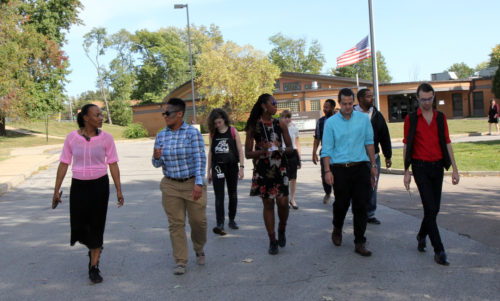
Shawntelle Fisher of SoulFisher Ministries and Cornita Robinson, director of development for St. Stephen’s & The Vine, lead pilgrims on a walk from Koch Elementary School to the Michael Brown memorial site. Photo: Lynette Wilson/Episcopal News Service
In the aftermath of Brown’ death much attention has focused on policing and racial profiling. The pilgrims traveled to Ferguson in search of a better understanding of what happened that day and the protests and community response that has followed, both in the context of Ferguson and in their own lives. The intention was that pilgrims would bring that understanding back to their work, churches and communities, and begin to tell their own stories.
“We need to create spaces where people are telling their stories and actually being heard. And I think part of it is young people doing the work in their own context and doing the work in the spaces they inhabit,” said Leandra Lambert, a young adult member of the Union of Black Episcopalians who helped plan the pilgrimage, adding that anti-racism committees and anti-racism trainings for leaders are not enough.
“There are also spaces where decisions are being made and it would be helpful to us to know exactly where those spaces are, what committees, what organizations, exactly where in the church do we need to be so we are at the table, because if you are not at the table you are on the table,” she said. “A critical piece is not just saying it’s important to have people engaged, but really working towards that and taking those conversations to heart and putting the resources behind it.”
The Episcopal Church sponsored the Oct. 8-12 pilgrimage, which brought together a cross section of young adults aged 19 to 34, representing white, black, Hispanic, Native American, Pacific Islander and mixed-race people from across church to study racial justice and reconciliation in the context of Ferguson. The pilgrimage was funded via a grant of the Constable Fund approved by the Executive Council of the Episcopal Church in early 2015.
The four-day pilgrimage included two visits to the site where Brown died, presentations and conversations with local clergy, non-profit and community leaders, small table discussions and worship.
Brown, 18, was fatally shot by a white Ferguson police officer, Darren Wilson, after an altercation. Wilson later testified that he stopped Brown and his friend because they matched the description of two teenagers involved in the robbery of a convenience store moments earlier. Video surveillance indicated Brown had robbed the store.
A struggle ensued between Wilson and Brown, and Wilson fired multiple shots at close range into the head and chest of Brown, who was unarmed.
Protesters quickly took to the streets and images of police officers in riot gear clashing with them filled television and computer screens. The protests that followed Brown’s death continued into November 2014 when it was announced that a grand jury decided not to charge Wilson in Brown’s death. An independent federal investigation initiated by the Justice Department later cleared Wilson of violating Brown’s civil rights but raised multiple concerns about racial disparities in the Ferguson police department’s conduct of its duty. On the anniversary of Brown’s death another protest broke out and a state of emergency was declared.
Ferguson becomes a national focal point
Ferguson, a suburb of St. Louis, is 67 percent black, and a quarter of its 21,086 residents live below the poverty line. Brown’s death put Ferguson on the map; the community has become a nationwide symbol of racial disparity and injustice and the relationship between law enforcement and communities of color.
Ferguson also has become a symbol of hope and a site for pilgrimage in a quest for understanding what happened the day Brown was shot and the protests and grassroots and community responses that have followed.
For the pilgrims, many of whom work for or serve the church in some capacity, the pilgrimage was an opportunity to learn about what happened in Ferguson and to take the lessons and stories back into their own communities, churches and work.
“These young people are not the future of our church, they are the here and now of our church. They are the growing edge of our church, and they are our best ambassadors and best evangelists. They are our best missionaries to other youth and young adults in the church – they can spread the word of who we are,” said Heidi Kim, the Episcopal Church’s missioner for racial reconciliation.
“I think that they have a different and powerfully compelling notion of what makes our church relevant, and I would love to see that message work its way throughout the rest of the church,” said Kim. “I think they understand very clearly what it means to be Christ’s hands and feet in the world. So for them ministry is about worship and liturgy and studying and reflection, but it’s also about being present in a world that is suffering, and moving and engaging in a way that will bring grace and healing.
“My belief is not that The Episcopal Church is here to save Ferguson, but that the lessons from Ferguson can redeem The Episcopal Church. I think that the prophetic witness of these young people can help to redeem us all.”
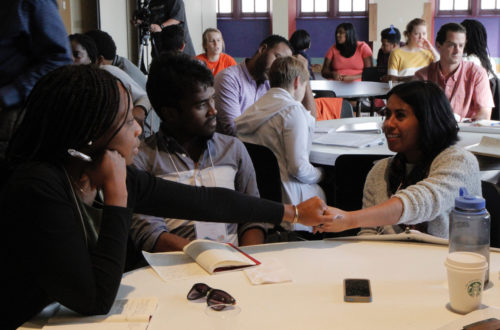
Leandra Lambert of the Union of Black Episcopalians, Sitraka Andriam of the Diocese of California and Erendira Jimenez-Pike of the Diocese of Kentucky participate in a small-group discussion at Christ Church Cathedral in downtown St. Louis on Oct. 10. Photo: Lynette Wilson/Episcopal News Service
Many of the pilgrims were anticipating incorporating their experience on the pilgrimage into programs and curricula to facilitate conversations and healing in their own communities.
For instance, Donnecia Brown is participated in Servant Year, a 15-year-old program in the Diocese of Pennsylvania that places Episcopal Service Corps members in intentional communities and pairs them with social service agencies, schools and social justice community organizations. She is working on building up a support group for teens by teens to address the culture of violence and the community trauma that young people face every day in Philadelphia.
Aaron Rogers, of the Diocese of Newark, works with the Newark Mentoring Movement, and is seeking to connect leaders in his community to leaders in Ferguson.
Timothy J.S. Seamans, who serves as school chaplain at Holy Innocents Episcopal School in Atlanta, Georgia, is developing a justice curriculum centered in healing and particularly racial healing for schools.
Short- and long-term response
In the immediate aftermath of Brown’s death, the Episcopal Church and Episcopal Relief and Development awarded the Diocese of Missouri a $40,000 grant to address domestic poverty, pastoral and community work in northern St. Louis County, where Ferguson is located.
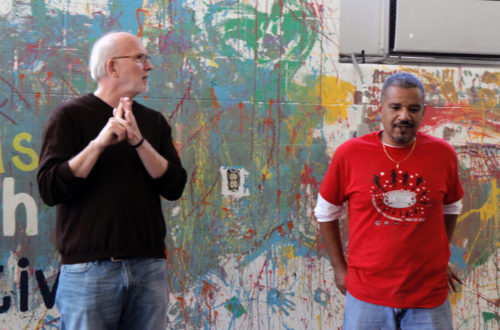
The Rev. Steve Lawler, rector of St. Stephen’s & The Vine in Ferguson, and Ferguson Councilman Dwayne T. Davis talk about the Ferguson Youth Initiative, housed in an old firehouse attached to City Hall, on Oct. 10. Photo: Lynette Wilson/Episcopal News Service
Before Brown was killed and protesters took to the streets of Ferguson, the Rev. Steve Lawler, rector of St. Stephens & the Vine, and Pastor F. Willis Johnson, of Wellspring Church, had done asset mapping in the community. They were poised to respond to the immediate needs of residents who were confined to their homes because of the protests and the militarized police presence that shut down buses and businesses.
St. Stephen’s food pantry delivered food and toilet paper to people stuck inside.
The asset mapping also made Lawler and Johnson recognize that they needed to focus on economic growth and social engagement, said Lawler.
To that end, St. Stephen’s started Incubate Ferguson as a way to encourage small business development and Wellspring founded The Center for Social Engagement and Justice as a way to foster and offer space to nonprofit, grass-roots organizations.
“Most economic growth that is going to reasonably occur here is going to be small-business growth,” said Lawler. “Even if you are given job-preparedness training the real question is, where are the jobs? Where are jobs that you can actually live on? That’s why we are focusing on business creation.”
In addition to loss of manufacturing jobs over the last 40 years, Ferguson was hit particularly hard during the mortgage crisis, with 50 percent of the community’s 6,000-plus homeowners owing more than their homes were worth.
Throughout the pilgrimage, a picture of Ferguson began to emerge that went beyond the death of Michael Brown and the subsequent protests.
Historical prejudice
On the first full-day of the pilgrimage and again on the eve of departure, the pilgrims had an opportunity to listen and ask questions of Bishop Wayne Smith and to learn about some of the ways the diocese responded in the short- and long-term.
In their first meeting, Smith outlined the St. Louis metropolitan area’s political and geographical boundaries and explained how the region became one of the most racially segregated in the country.

Pilgrims Timothy J.S. Seamans of the Diocese of Atlanta and Dominique Bocanegra of the Diocese of Massachusetts take part in a small-group discussion on Oct. 10 at Christ Church Cathedral in downtown St. Louis. Photo: Lynette Wilson/Episcopal News Service
As far back as 1876, the city of St. Louis removed itself from St. Louis County, “the city thought it had all the space it needed,” explained the bishop. The city of St. Louis has 22 wards, each represented by an alderman, and the county was long ago carved up into 90 separate municipalities, which he described as “political fiefdoms that set the grid work for segregation.”
Smith described Ferguson as an inner-ring suburb once home to white working-class residents who labored in big three auto factories and the former aerospace manufacturer and defense contractor McDonnell Douglass, which was headquartered in St. Louis County.
“Twenty years ago, Ferguson was 80 percent white and 20 percent African-American, that has now flipped,” Smith said.
Later that same day, the pilgrims heard from the Rev. Chester Hines, a deacon at Christ Church Cathedral in downtown St. Louis and one of two black clergy in the diocese, who shared his story of living three-quarters of a century in St. Louis.
“I’ve seen a lot,” said Hines, who as an infant was brought to St. Louis by his parents who were sharecroppers in Mississippi.
Hines talked about geopolitical factors and the long history of institutionalized racism that has existed in public education, public safety and policing, the judicial system, housing and economic development – the environment that led to Brown’s death and the protests in Ferguson.
With more than 90 municipalities in St. Louis County there’s “fighting over the limited resources available to support and sustain communities.”
In fact, one of the things the Department of Justice’s investigation into the Ferguson Police Department uncovered was that city officials put making money, through traffic tickets and other citations, above providing public safety to the community. It also found that Ferguson’s black residents were disproportionately targeted.
Hines also outlined how the public schools ignored the 1954 Supreme Court ruling to end segregation of schools. It wasn’t until a black parent sued one of the districts in 1972 that “voluntary desegregation” was implemented under threat that schools would face the loss of federal funds. Still, he said, desegregation wasn’t fully achieved, to the extent that it has been, until the 1990s.
Hines described race as “the horse in the middle of the table” that no one wants to talk about. “The psychology of our community is that we live in a state of denial … we are our own worst enemy,” he said.
The rise of community leaders
Leaders are emerging, however, in people like Shawntelle Fisher, who started a nonprofit organization to address the school-to-prison pipeline and the problem of mass incarceration, and like Felicia Pulliam, who serves on the Ferguson Commission, created to study the underlying social and economic conditions underscored by the unrest in the wake of Brown’s death.
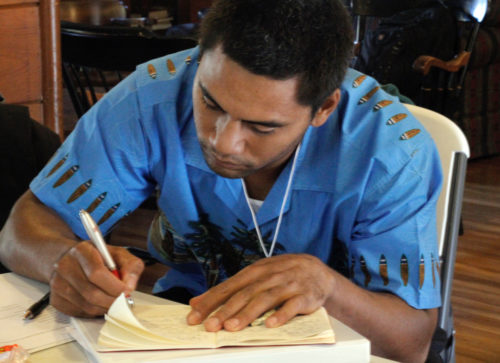
Nicholas Lino of the Diocese of Hawaii writes in his journal during the Ferguson Pilgrimage Oct. 8-12 sponsored by the Domestic and Foreign Missionary Society. Photo: Lynette Wilson/Episcopal News Service
Before the commission could produce the Ferguson Report, its members had to hold meetings and listen to the marginalized voices in the community. At first she said, “hundreds and hundreds of angry people would show up, we spent hours listening.”
Pulliam has lived most of her life in north St. Louis County; she remembers when her family left the city for the suburbs, she watched as the Baskin-Robbins closed and liquor and payday loans stores opened.
“I watched the community change; black people try to move here to make a better life and this happens,” she said.
Policing and the criminal justice system are two things the Rev. Gayle Fisher-Stewart, a transitional deacon in the Diocese of Washington who served 20 years in the Metropolitan Police Department in Washington, D.C., knows something about.
Fisher-Stewart led the pilgrims through an exercise on Oct. 11 where they were the police recruits and she played the role of police captain. She asserts that community policing in minority neighborhoods is a fallacy and that “the police are not change agents, they are the status quo.”
Citing works such as Kelly Brown Douglas’ “Stand Your Ground: Black Bodies and the Justice of God,” Fisher-Stewart contends that today’s U.S. policing practices are based on the slave patrols in the South, and that “the criminal justice system needs fuel – bodies – and the police are the gatekeepers.”
Brown’s death came less than a month after Eric Garner, 43, was killed in a chokehold by a New York City police officer on Staten Island, and four days after police shot and killed John Crawford, 22, in Beavercreek, Ohio. In Cleveland on Nov. 23, 2014, a police officer killed 12-year-old Tamir Rice. (Last week investigators ruled the shooting of Rice was justified.
A need to address institutional racism
Throughout the four-day pilgrimage, participants said it became increasingly obvious that racial reconciliation cannot be achieved until the structural and institutional racism is addressed, and that all people, black, white, Hispanic, Native American, Asian, and Pacific Islander face one another as equals.
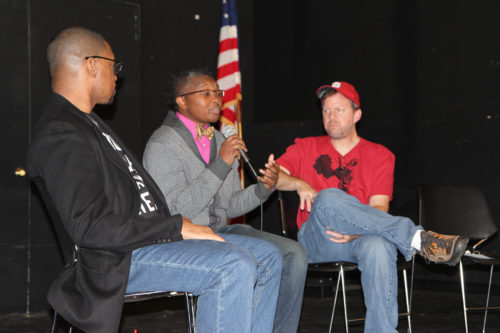
The Rev. Starsky Wilson, pastor of St. John’s Church, St. Louis, Pastor Phiwa Langeni of Zion United Church of Christ, and the Very Rev. Michael D. Kinman, dean of Christ Church Cathedral in St. Louis, talk during an Oct. 10 panel discussion on “The Role of the Prophet.” Photo: Lynette Wilson/Episcopal News Service
On Oct. 10, both a panel on “The Role of the Prophet” and Chuck Wynder Jr., the Episcopal Church’s missioner for social justice and advocacy engagement addressed the topic of racial justice.
“In order to have reconciliation there has to be justice making, (and) part of that justice making is affording the person or the group that has been harmed to name the harm, to speak to the harm, and to state what they need in order to be whole,” said Wynder in an interview with ENS. “There’s still a need in our communities to repair the breach and make justice in order for people to sit down in our communities and heal the wounds.”
Reconciliation is a dynamic and active process, he said.
“That’s why we talk about racial justice and reconciliation, if you speak about reconciliation first it can be perceived that you just want to make a cheap peace, you just want to have calm, and even at the personal level often people don’t want to repair the breach, they just want to have peace with the other person without saying I’m sorry and doing the work to make the other person whole,” said Wynder. “It’s much more complex when we talk about it at the institutional, systemic and cultural level, but the same principles apply.”
A second walk, a deeper understanding
After the pilgrims’ second visit to the site where Michael Brown was fatally shot, they began to prepare to go back into their own communities, and some shared new insights.
“The first time I went there was so much going on – I was learning so much about St. Louis and Ferguson and everything that led up to that event that I was a little over-stimulated and overwhelmed and I couldn’t quite process it,” said Adiel Pollydore, a member of Episcopal Service Corps resident of Life Together in Boston.
Pollydore is from Albany, New York, where she said gun violence also is an issue.
“I think that as I had more time to process, and then going back on Sunday I really allowed myself to feel all of the emotions. And I was surprised that sure enough there was that initial tang of like hurt and pain, but also an overwhelming feeling of hope as I was able to learn what has come out of this place and what this dramatic, traumatic event has done for the people of Ferguson in terms of really bringing about change. And that made me really hopeful.”
Pollydore works with youth in Boston interested in building a local movement. “Youth who are saying ‘You know what, being black and poor, being brown and poor in Boston and being a young person is hard and we want people to know about us and our stories and we want to feel connected to other young people who feel similarly disenfranchised and what can we do about it’,” she said.
Pollydore said she has a lot to bring back.
“I’ve learned so much from the activists and speakers about what that (starting and sustaining a movement) might look like and I’m excited to bring that back,” she said. “I’m also excited to push faith communities that I’m part of, including Life Together, and including St. Mary’s in Dorchester, to continue to think about race.
“I know there’s a lot of work done in both of those communities, and so thinking about sharing ways in which to tell this story and my story interacting with the larger story of Ferguson, I’m really excited.”
– Lynette Wilson is an editor and reporter for Episcopal News Service.

Social Menu